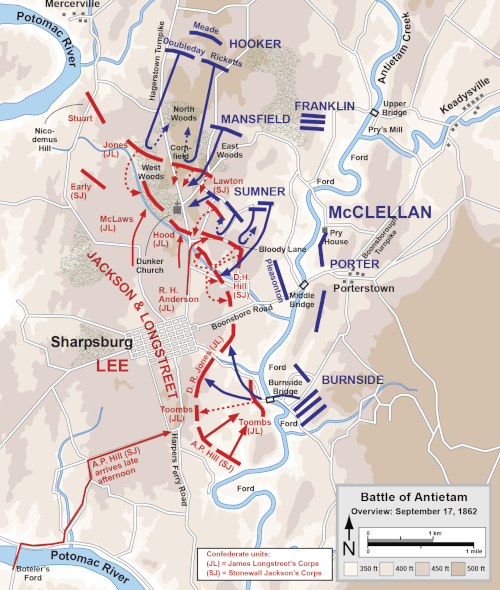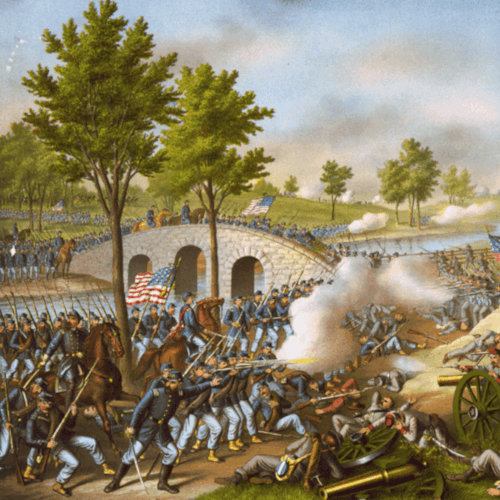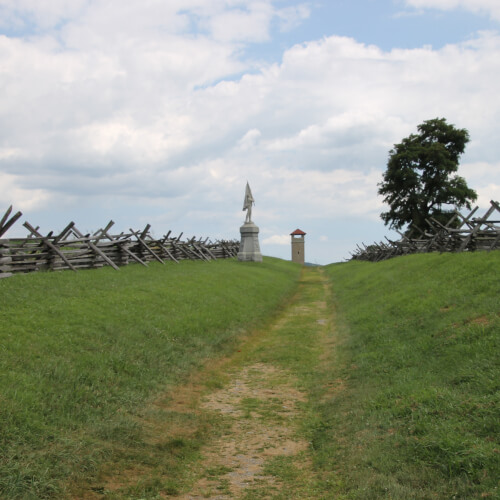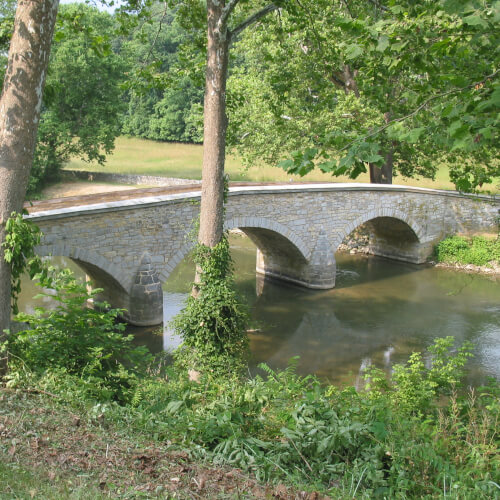Civil War Battles
Exploring some of the major Battles of the Civil WarThe Battle of Antietam
The Battle of Antietam was one of the most important events of the American Civil War. Fought on September 17, 1862, Antietam was the bloodiest single-day battle in American history with over 23,000 casualties (men listed as killed, wounded, captured or missing) in roughly 12 hours. The battle ended the Confederate invasion of Maryland in 1862 and resulted in a Union victory. It also led to President Abraham Lincoln issuing the Preliminary Emancipation Proclamation on September 22, 1862.
Prelude to Battle
After his victory at the Second Battle of Bull Run in Virginia, Confederate General Robert E. Lee took his troops and crossed the Potomac and moved into Maryland. Lee’s plan was to move the fighting out of Virginia and he had thoughts of capturing Washington, DC.
On September 9 Lee issued Special Order 191, in which he detailed how his troops would be deployed during the upcoming campaign. General Thomas “Stonewall” Jackson would be in charge of capturing Harper’s Ferry while the remaining Confederate troops would use South Mountains as cover to advance on Boonsboro, Maryland. Once the Union forces at Harpers Ferry had been defeated, Lee planned to invade Pennsylvania.
About this time, General George B. McClellan was put in command on the Union Army and by September 11, Confederate forces were spreading out throughout Maryland. On September 13 Federal troops moved into Frederick, and members of the 27th Indiana infantry regiment recovered a copy of Lee’s Special Order 191 wrapped around a bundle of cigars. Although the “Lost Orders” were four days old, McClellan felt emboldened enough to remark, “Here is a paper with which, if I cannot whip Bobby Lee, I will be willing to go home.”
On September 14 McClellan’s army struck the passes at South Mountain. The Battle of South Mountain was a convincing Union victory, but the Confederate defenders managed to delay the Union advance long enough for Lee to begin the consolidation of his scattered forces.
On the morning of September 15, Union troops discovered 11,000 Southern soldiers defending Sharpsburg, Maryland. McClellan overestimated the size of the Confederate army and spent the 16th scouting the enemy.
The Battle Begins
The battle opened around 5:30am on September 17 when Union General Joseph Hooker took his 8,500 men and attacked Confederate forces down the Hagerstown Pike toward the Dunker Church. Union troops continued to spread out and attacked Stonewall Jackson and his Confederate troops in the East and West Woods and in Miller’s Cornfield.
As Union troops entered the cornfield, artillery fire erupted from the west and from the area near the Dunker Church. As the Confederate canons fired, Union artillery returned fire and the damage caused by this canon fire was termed “Artillery Hell.” A combined total of 500 guns fired mostly from small rises with long, clear lines of sight. Rocky outcroppings throughout the battlefield caused solid-shot shells to ricochet. General Hooker
The Cornfield and Bloody Lane
For the next several hours, Union General Hooker’s I Corps and Major General Joseph Mansfield’s XII Corps fought against Stonewall Jackson for control of Miller’s 24-acre cornfield. The Cornfield changed hands no less than six times during the figting as each side advanced and retreated and by 9:00am, neither side held an advantage.
At this point, both sides paused and regrouped. However, it didn’t take long before 5,000 men of the Union II Corps marched toward the West Woods. Shortly after moving into the woods, a Confederate attack struck the flank of the Union soldiers and in twenty minutes, 2,200 out of 5,300 men had fallen killed or wounded. By 10:00 a.m., the heavy action on the north end of the field subsided. Close to 10,000 soldiers had been killed or wounded during those first four hours of fighting.
By early afternoon, the fighting had shifted to a sunken road between farms. Confederate forces stood their ground as Union soldiers repeatedly attacked and fell back. Finally, Union attackers assumed a position from which they could shoot down on the Confederate soldiers occupying the road. It was quickly filled with the dead and dying, sometimes two and three deep. The road would become known as Bloody Lane.
Burnside Bridge
As the fighting was raging in Bloody Lane, Union troops under Major General Ambrose Burnside were attempting to cross Antietam Creek. Burnside’s objective was to cross the creek and attack the right flank of the Confederate line. Unfortunately for Burnside, Confederate forces from Georgia and South Carolina turned the stone bridge into a kill zone, and Burnside spent more than three hours trying to force a crossing. With their ammunition all but exhausted, the Confederate defenders were at last driven back by a Federal bayonet charge.
Burnside then took his 8,000 men and crossed the Antietam and around 3:00pm launched an attack on the remaining Confederates who were dug in on the heights around Sharpsburg. As the Union forces began to push back the enemy flank, it appeared that Robert E. Lee and his troops could not win the battle. Just as all was thought to be lost, AP Hill’s troops arrived from Harper’s Ferry after marching 17 miles in eight hours. Hill’s attack shattered the Union advance, and by 4:30 PM the Federal left flank was in full retreat. This counterattack ended the battle and General Lee took his troops and crossed back over the Potomac into Virginia. This ended the fighting on what would be the single bloodiest day in the history of the United States.
Key Players in the Battle of Antietam
Robert E. Lee
Robert Edward Lee was an American and Confederate soldier, best known as a commander of the Confederate States Army. He commanded the Army of Northern Virginia in the American Civil War from 1862 until its surrender in 1865
George B. McClellan
George Brinton McClellan was an American soldier, civil engineer, railroad executive, and politician. A graduate of West Point, McClellan served with distinction during the Mexican–American War, and later left the Army to work on railroads until the outbreak of the American Civil War.
AP Hill
Ambrose Powell Hill Jr. was a Confederate general who was killed in the American Civil War. He is usually referred to as A. P. Hill to differentiate him from another, unrelated Confederate general, Daniel Harvey Hill.
Ambrose Burnside
Ambrose Everett Burnside was an American soldier, railroad-executive, inventor, industrialist, and politician from Rhode Island. He served as the Governor of Rhode Island from 1864 to 1869, and as a United States Senator for Rhode Island from 1875 until his death.
Learn More
Videos
Vocabulary
Sharpshooter: a person who is very skilled in shooting.
Reconnaissance: military observation of a region to locate an enemy or ascertain strategic features.
Garrison: the troops stationed in a fortress or town to defend it.
Emboldened: give (someone) the courage or confidence to do something or to behave in a certain way.




